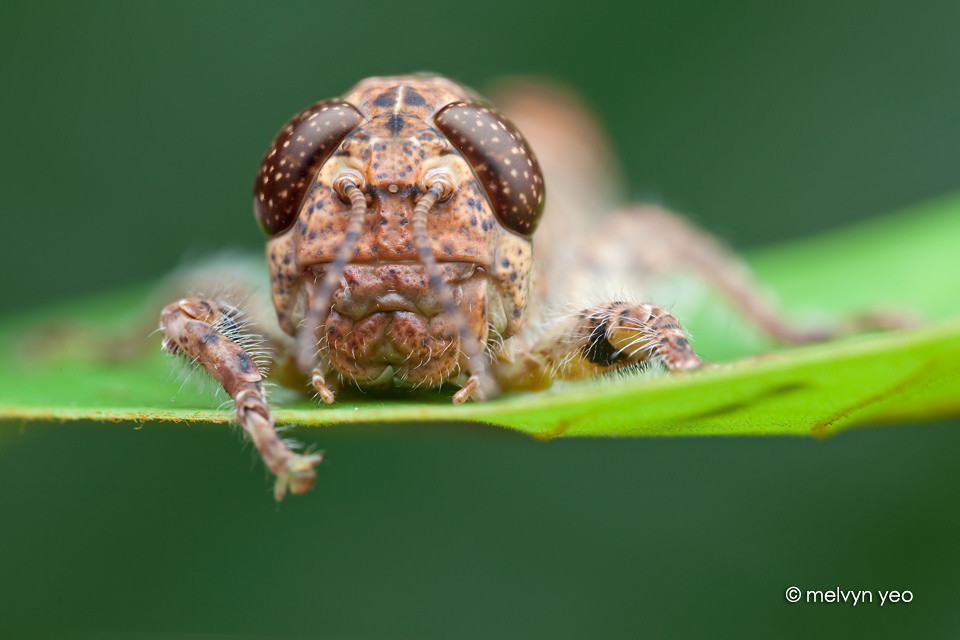HOME | DD
 melvynyeo — Grumpy looking Grasshopper
melvynyeo — Grumpy looking Grasshopper

#grasshopper #grumpy #looking
Published: 2014-10-08 09:18:21 +0000 UTC; Views: 2409; Favourites: 75; Downloads: 49
Redirect to original
Description
Somehow, this grasshopper look like a grumpy old man to me





 Taken at night in Singapore.
Taken at night in Singapore.Quote from en.wikipedia.org/wiki/Grasshop…
Grasshoppers have antennae that are generally shorter than their body and short ovipositors. They also have pinchers or mandibles that cut and tear off food.[1] Those species that make easily heard noises usually do so by rubbing the hind femurs against the forewings or abdomen (stridulation), or by snapping the wings in flight. Tympana, if present, are on the sides of the first abdominal segment. The hind femora are typically long and strong, fitted for leaping. Generally they are winged, but hind wings are membranous while front wings (tegmina) are coriaceous and not fit for flight. Females are normally larger than males, with short ovipositors. Males have a single unpaired plate at the end of the abdomen. Females have two pairs of valves (triangles) at the end of the abdomen used to dig in sand during egg laying.
They are easily confused with the other sub-order of Orthoptera, Ensifera (crickets), but are different in many aspects, such as the number of segments in their antennae and structure of the ovipositor, as well as the location of the tympana and modes of sound production. Ensiferans have antennae with at least 20–24 segments, and caeliferans have fewer. In evolutionary terms, the split between the Caelifera and the Ensifera is no more recent than the Permo-Triassic boundary (Zeuner 1939).
Grasshoppers prefer to eat grasses, leaves and cereal crops, but many grasshoppers are omnivorous.[3] The majority of grasshoppers are polyphagous. Many will eat from multiple host plants in one day, while some prefer to rely on the same host plant. Only one[specify] of the 8000 species of grasshopper is monophagous and will only eat a single species of plant.[4]
The digestive system of insects includes a foregut (stomodaeum, the mouth region), a midgut (mesenteron), and a hindgut (proctodaeum, the anal region). The mouth is distinct due to the presence of a mandible and salivary glands. The mandible can chew food very slightly and start mechanical digestion. Salivary glands (occur in buccal cavity) chemically digest the carbohydrates in the grasses and similar foods they eat. The buccal cavity continues with pharynx, esophagus and crop. The crop has the ability to hold food. From the crop, food enters the gizzard, which has tooth-like features in it. From there, food enters the stomach. In the stomach, digestive enzymes mix with the food to break it down. These enzymes originate from the gastric caeca surrounding the stomach. This leads to the malpighian tubules. These are the chief excretion organs. The hindgut includes intestine parts (including the ileum and rectum), and exits through the anus. Most food is handled in the midgut, but some food residue as well as waste products from the malpighian tubules are managed in the hindgut. These waste products consist mainly of uric acid, urea and amino acids, and are normally converted into dry pellets before being disposed.
The salivary glands and midgut secrete digestive enzymes. The midgut secretes protease, lipase, amylase, and invertase, among other enzymes. The particular ones secreted vary with the different diets of grasshoppers.



























